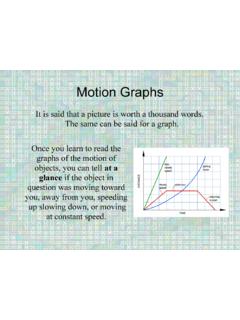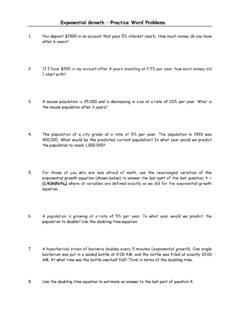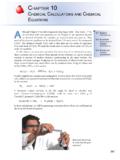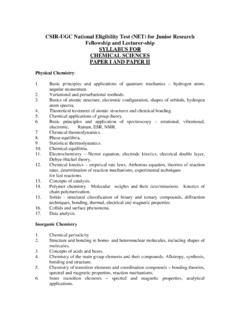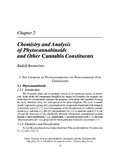Transcription of chap 06 Random Errors in Chemical Analysis 07 - SUNY …
1 1 Slide 1 Random Errors in Chemical AnalysisChapter 6 Skoog, West, Holler and Crouch8thEditionSlide 2 Fig 6-CO, 3A. Nature of Random Errors Uncontrollable variables are the source of Random Errors Contributors to Random Errors are not all identifiable individually detectable quantifiable The combined effectof Random Errors produce the fluctuation of replicate measurements around the mean Random Errors are the major source of 4 Distribution of Random ErrorsTable 6-1, four contributors to the Random error of equal probability of occurrence of negative and positive can cause the final result to be high or low by U3 Slide 5 Frequency of Occurrence and Probability The frequency of a deviation of a given magnitude is a measure of the probability of occurrence of that deviationFig 6-2a, 6 For ten equal size uncertaintyFig 6-2b, 7 Gaussian Curve or Normal Error Curve For a very large number of individual errorsFig 6-2c, 8 Distribution of Experimental ErrorsTable 6-2.
2 9 Sources of Random fluctuations in the calibration of the pipetSlide 10 Generating a histogramFrequency within rangesTable 6-3, 11 Table 6-f1, of the Experimental Errors Approachesa Gaussian CurveSlide 12B. Statistical Treatment of Random Errors Distribution of the majority of analytical data displays characteristics of the normal distribution Therefore, Gaussian distribution is used to approximate distribution of analytical data Exceptions exists Photon counting: poisson distribution Isotopes of an elements: binomial distribution Available standard statistical methods are used to evaluate analytical data assuming Random distribution of errors7 Slide 13 Fig 6-3, 14 Terminology Population: all possible observations/ measurements/a universe of data Types of population Finite and real (lot of steel, a lot of Advil Tablets) Hypothetical or conceptual (Calcium in blood, lead in lake Ontario).
3 A sample of the population is analyzedSample: subset of the population Results from the Analysis are used to infer the characteristics of the population8 Slide 15 Properties of Gaussian Curves Gaussian curve Equation()deviationdardspopmeanpopulatio nvaluedataxxey =tan:::2222 Slide 16 Parameters in the Gaussian Equation The gaussian curve is fully characterized by two parameters the mean: the standard deviation: Population mean ( ) and Standard Deviation( )()NxNxNiiNii == ==121 **9 Slide 17 A statistic: estimate of a parameter of the population obtained from a sample of data. Examples are: Sample mean: Sample standard deviation:xsSlide 18 Universal Gaussian Curve222122121zxeyxzey = == Abscissa: deviation from the mean in units of standard deviation10 Slide 19 Properties of a normal error curve Mean occurs a the central point of maximum frequency Symmetrical distribution of positive and negative deviations Exponential decrease in frequency as the magnitude of the deviations increasesSlide 20 Using the Gaussian Curve Fraction of the population between two limits is given by the area under the curve between the two limits The probability of a single event between two limits is given by the fraction of the area between the two limits11 Slide 21 Calculating the Areas Under the Gaussian Curve Fraction of the population between two limits is given by the area under the curve between the two limits gives the probable error of a single measurement()
4 Dzeareadzeareadxeareazzx Slide 23 The Sample Standard Deviationx Number of degrees of freedom: number of independent results needed to compute the standard deviation As N approaches infinity, s approaches and approaches ()iancesamplesNxxsNxxNiiNiivar:12121 == ==xSlide 24 Standard Error of the Mean The standard deviation of the mean = standard error of the meanNssm=13 Slide 25 Reliability of s as a Measure of Precision As N increases s becomes a better estimator of Typically when N>20, s is considered to be a good estimator of Pooling data improves the reliability of s. Assumptions same sources of Random error in all measurements Random samples of the population are drawn ( same ). s pooled is the weighted average of the individual estimates of .Slide 26 Pooled Standard Deviation()()()tNiNkkNjjipooledNNNN xxxxxxs ++++ + + = ===.
5 32111231222113214 Slide 27C. Standard Deviation of Calculated Results Standard Deviation of a Sum or DifferenceThe variance of a sum or difference is equal to the sum of the individual variances Standard Deviation of a Product or a QuotientThe square of the relative standard deviation of a product or a quotient is equal to the sum of the squares of the relative standard deviations of individualSlide 28 Table 6-4, 29D. Significant Figures All certain digits plus one uncertain digit Rules All initial zeros are not significant All final zeros are not significant, unless they follow a decimal point Zeros between nonzero digits are significant All remaining digits are significant Use scientific notation to exclude zeros that are not significant Slide 30 Significant figures in Numerical Computations Sums and differences Products and Quotients Logarithms and Antilogarithms Rounding Data






